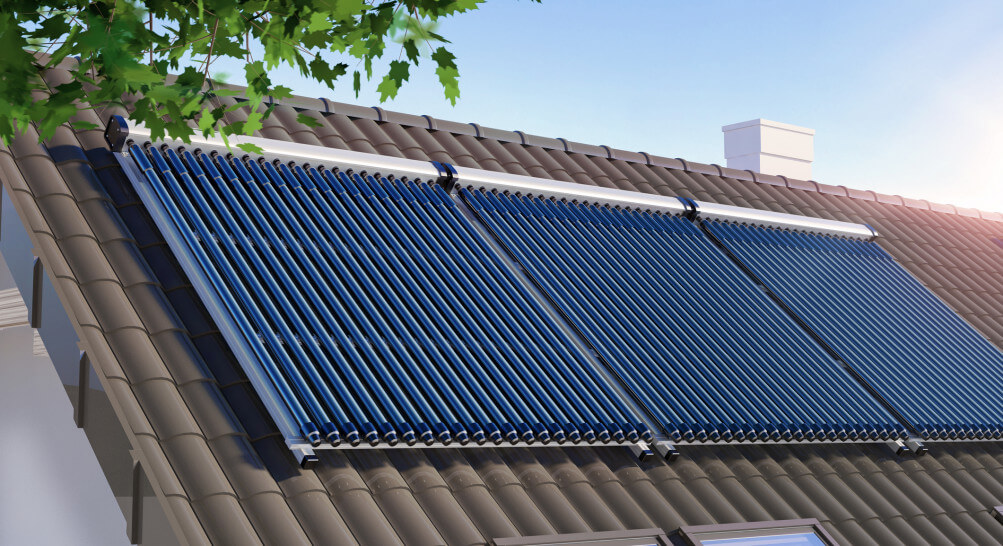For nothing goes the sun. So you should take advantage of that, for instance by buying and installing a solar water heater. A solar water heater is a sustainable investment that can help you save a lot on gas costs. In this article, we will explain how a solar boiler works and what its advantages are. We will give you some price examples and tips on who to hire to install a solar water heater.
What is a solar water heater and how does it work?
A solar water heater uses sunlight to heat water. You can use this hot water for showering or cooking.
As standard, a solar water heater consists of three parts:
- The solar collector
- The storage tank (the boiler)
- The reheater
The solar collector
A solar collector is nothing but a plate placed on the roof that captures sunlight. You can compare it a bit to a solar panel. It is a tube system containing liquid, connected to a storage vessel. The heated liquid (temperatures up to 90 degrees possible) then heats the water in the storage tank via the pipe system. There are two types of solar collectors:
- The flat plate solar collector
- The vacuum tube solar collector
The flat-plate solar collector is a panel with a plate that absorbs and retains heat in the panel. A pipe system transports the heated water to the storage tank. The flat-plate solar collector is cheaper than the vacuum tube solar collector, but has a lower efficiency at lower outdoor temperatures.
The vacuum tube solar collector works the same as the flat plate solar collector. The difference is in the special coating of the tube system. This allows the heat to be retained longer. In addition, the liquid is contained in a vacuum, creating yet another insulating effect. Therefore, compared to the flat plate solar collector, the vacuum tube solar collector is more expensive. On colder days, however, you have a higher efficiency. As a result, the after-heater (more on this later) does not have to be switched on as often.
There is also a choice between a pressure-filled system and a backflow system.
In a pressure-filled system, the fluid, which is always in the entire pipe system, is under pressure. The fluid also contains antifreeze, as the fluid should not freeze. This makes this system slightly more expensive but is a good choice when the solar collector is not right above the boiler (the storage tank).
With a backflow system, when the boiler is not in operation, the liquid is in a storage vessel. Antifreeze is not needed, making maintenance of this system relatively cheaper.
The boiler (the storage vessel)
The boiler, which comes in different sizes, is filled with tap water. The boiler and the solar collector are connected through the pipe system. The heated liquid from the solar collector keeps the water in the boiler at temperature until you need it. So hot water is always immediately available.
The after-heater
Unfortunately, the sun never shines 365 days a year. On cloudy days, a solar collector has a lower efficiency than on sunny days. To ensure that you always have enough hot water available, your solar boiler is connected to a so-called after heater. This is usually your central heating boiler. This ensures that, if the water in the boiler is not hot enough, the water is brought and kept to the right temperature.
Other options
Although they are less common in the Netherlands, we will mention the compact solar water heater, which is especially suitable for sunny climates. A compact solar boiler does not require a separate boiler. The water supply is located near the solar collector, which is therefore a bit heavier and higher.
With a solar boiler combi, you can also heat your home. So this boiler contains an integrated central heating boiler, which also controls the central heating. In the Netherlands, however, this is usually done in combination with a heat pump.
What does a solar boiler cost?
Do you want to proceed with buying and having a solar boiler installed but have no idea what a solar boiler will cost? You can have a solar water heater in your home from as little as €2,000. That amount includes the installation (which is best left to one of Zoofy's professionals). The higher the number of litres of hot water you want, the higher the cost will be. As a rule of thumb, you can assume that the hot water requirement per person is 50 litres.
In the table below, we have listed some price examples for you.
Average volume/number of litres Number of solar collectors Average costs including installation Average savings in gas consumption per year
100 litres 1 € 2,200 - € 2,600 100 m3
100 litres 2 € 2,800 - € 3,400 135 m3
200 litres 2 € 3,400 - € 3,800 185 m3
300 litre 3 € 4,800 - € 5,600 285 m3
